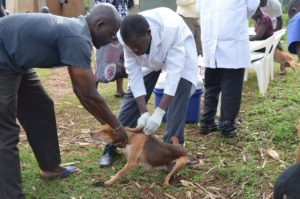By Okong’o Oduya
Busia County, Kenya: Kakamega, Busia, and Vihiga Counties are reporting a high number of rabies infections as a result of dog bites, experts say.
Rabies is a big threat to the lives of Kenyans but it is unfortunate that some dog owners do not know the risks of keeping a dog that has not been vaccinated.
Victims of dog bites don’t know how to manage dog wounds that lead to the development of the virus in the brain killing about 60,000 people every year, the majority of deaths being reported in Africa and Asia
Dr. Kennedy Owuor is Kenya Veterinary Association, secretary Busia branch says in Western Kenya; Kakamega, Busia, and Vihiga Counties are among the leading counties in rabies infections which is caused by numerous sugar bushes and a large forest cover that offer habitats for wild canines that play an important role in rabies transmission causing deaths before the cases are reported to any health facility.
He says most Victims instead of seeking medical attention, report such cases to chiefs and veterinary offices.
According to him, rabies is a neglected zoonotic disease that is nearly always fatal in humans if appropriate preventive measures are not taken after exposure.
“Worldwide, rabies causes approximately 60,000 deaths annually mainly in developing countries with one person dying of rabies every 10 minutes with more than 95 percent of human deaths being reported in Africa and Asia- and children below 15 years of age are at the greatest risk of rabies exposure and in Kenya rabies is estimated to kill 2,000 people every year.” He said.
He noted that there is important for Busia residents to be sensitized on how to take care of their dogs and how to manage wounds if at all they are bitten.
Late last year Western Branch of the Kenya Veterinary Association Busia branch carried out the anti-rabies campaign in Busia County by vaccinating dogs and cats as one of the measures to curb the increase of rabies cases in the county.

Peter Wanjala a resident of Mayenje in Busia county one of the beneficiaries admit that majority of people in Busia do not take the issue with vaccinating their dogs and cats seriously, adding that it is important for the vaccination to take place so that in case of any bite the victim can only seek anti-tetanus injection.
“I want to appeal to dog owners to vaccinate their pets to reduce cases of rabies in the county. There is a need for Kenya Veterinary Association to take action against those who fail to vaccinate their dogs once a year.” He noted.
Joseph Okwara a resident of Simbachai, Teso South resorted to the traditional way of treating dog bites after he was referred to Busia County hospital from Amukura health center.
According to him, there was no traveling to Busia required time, which might have led to rabies infections.
“Last year I was bitten by a neighbor’s dog. I went to Amukura health center for treatment but I was referred to Busia county referral hospital due to long-distance, I resorted to addressing the problem locally,” he said.
The complete dose of rabies contains five treatment rounds each of which costs between 25,000 and 30,000 KSH.
International organizations have for many years endorsed the global goal of elimination of human deaths from dog rabies by 2030.
For Kenya, the focus on rabies was informed by the results of an exercise that mapped diseases in the country. It placed rabies as one of the top five animal diseases that affect people in the country.
However, Owuor revealed that one of the major challenges they face when addressing the issue of rabies in the county is that during the vaccination the dog owners will bring their adult animals for vaccination leaving behind puppies.
He further said the lack of proper statistics on the exact number of dogs and cats that exist in the county hampers the effective execution of the vaccination process.
He encourages people to get post-exposure treatment through awareness to help prevent bites.
Catherine Anyango the resident of Butula narrates how he survived the bite after she rushed to Khunyangu health center for medication. Anyango says she received first aid at the health facilities before she was rushed to Busia county referral hospital for proper medication.
According to her, she was referred to the county hospital because the facility did not have drugs to treat rabies.
“I was bitten by my neighbor’s dog last year, I was taken to Khunyangu health facility but did not have the rabies vaccine that is when I was referred to Busia County referral hospital for treatment,” she recounted.
According to the center for disease control (CDC), Rabies has been endemic in Kenya since the first case was reported in 1912. In Kenya 2, 000 people die annually of rabies after being bitten by dogs.
Despite this elevated mortality, current efforts to prevent rabies infections have mostly been restricted to treating individuals after a dog bite and random dog vaccinations, with little investment in sustainable prevention and control plans.
In 2012 the government of Kenya set up a Zoonotic Disease Unit (ZDU) to improve the surveillance, prevention, and control of zoonotic diseases in the country. Rabies was identified as one of the highest priority diseases.
Centers for Disease Control and Prevention (CDC) in Kenya has been pivotal in the development of the rabies elimination plan by providing funding and technical assistance in the development of guidelines on surveillance, rabies prophylaxis, and dog vaccination.














